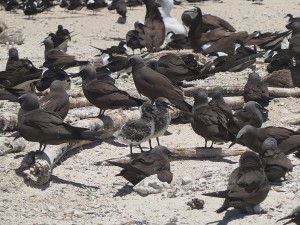With increasing evidence that Australia is set to experience a moderate to high El Niño effect in the second half of 2015, many species of animals on the Great Barrier Reef have the potential to be negatively affected. While many varieties of fish and wildlife living underwater can adapt to these changes by moving to cooler levels and locations, it is most often sea bird populations that directly feel the impacts of changing weather conditions. Disruptions to feeding patterns, breeding site availability, and protection from rising temperatures all can act together to wreak havoc on their ecology.
On Monday, 18th of May, Cairns locals were treated to a public lecture from Dr. Brad Congdon, held at the Salt House Restaurant and Bar. Dr. Congdon is a field ecologist with over 30 years of experience in the application of ecological and evolutionary theory to the management and conservation of animal and plant species with a special interest in seabird conservation. Dr. Congdon’s lecture shared results on his current research, which is focused on understanding how changing ocean conditions impact seabird breeding throughout the Great Barrier Reef and Coral Sea area. His research group was the first to demonstrate that seabirds are sensitive indicators of multiple climate-change impacts on top predators in these areas, and has also established that rising sea-surface temperatures are a major conservation issue for seabirds of the Great Barrier Reef.
Dr. Congdon’s research consistently shows that the food supply for many species of nesting sea bird chicks decrease with rising sea surface temperatures; both meal size and feeding frequency show a steady decline as sea surface temperatures rise. While it may not seem like much, a consistent increase of 2-4 degrees for as little as 2-3 weeks can have devastating impacts for species such as Sooty Terns, Black Noddies, and Wedge Tailed Shearwaters. What is even more interesting, Dr. Congdon’s research has shown that the behaviour of adult birds and how they feed can predict weather patterns for months to come; repeated studies have shown that the number of birds coming in to breed at a specific location can predict an El Niño event anywhere from 9 to 12 months in advance. El Niño occurs when sea surface temperatures in the central and eastern tropical Pacific Ocean become substantially warmer than average, causing a shift in atmospheric circulation. Typically, the equatorial trade winds blow from east to west across the Pacific Ocean; however, during El Niño events there is a weakening, or even reversal, of the prevailing trade winds. These changes are natural, but human activity contributing to climate change is thought to play an increasing role in the frequency of El Niño events.
In regard to seabird feeding behaviour, what is most alarming is that Dr. Congdon’s findings are not just limited to El Niño years; the trend of warmer sea surface temperatures has been reflected in various data sets for over ten years. Indeed, the last big El Niño event in 2002 provides a shocking glimpse of just how detrimental the effects of rising sea surface temperatures can be on nesting sea birds: In 2002, there was a total reproductive collapse of sea birds at colonies across the reef. Food sources such as baitfish reduced by as much as a third, and in some areas chick populations dropped by 50% (and even 100% in some places); the average expected mortality rate for nesting colonies is around 4%.
What is most disturbing is that, in addition to the impact of rising sea surface temperatures on chick populations, the effects on adult populations can be even more devastating. Adult birds of many species exhibit dual foraging processes, meaning that they split their time between foraging for their chicks and foraging for themselves. While adults forage relatively close to the colony for food for their chicks, they will travel as much as 1,000 kilometres away to find food for themselves; this is relevant because many of these feeding areas are outside of the Great Barrier Reef Marine Park, and as such, not under Marine Parks’ jurisdiction. Adult birds frequently coordinate their hunting of baitfish with large oceanic predators such as tuna: the tuna drive the baitfish into a ball from below, trapping them near the surface, and the birds feeding from the surface in-turn condense the ball from above, making it easier for the tuna to feed—one species cannot feed easily without the other. These feeding areas are near the largest tuna fishery in the world, and while Australia has in place some of the most sustainable seafood industry restrictions of any country, others are not so stringent. Decreases in tuna populations can directly impact the ability of adult seabirds to feed, and while a few years of declining chick populations are bad for a colony, a single year of high adult mortality can potentially be irreversible.
So what does this mean? In simple terms, oversight and management are needed in many of the world’s large fishery areas in order to protect not just stocks of fish, but other animals (including seabirds) that are directly or indirectly reliant on these big predators to survive. You may be reading this asking yourself “What can I do to make a difference?” The answer may surprise you: All that needs to be done is a little research. When buying fish products, opt for choices that specifically indicate that they are fished (or farmed) sustainably. Let your government officials know how important looking after the marine environment is. And do your part to protect not just the marine environment, but your local environment and community as well-reduce, reuse, recycle.
Remember: We have one planet, let’s take care of it.

